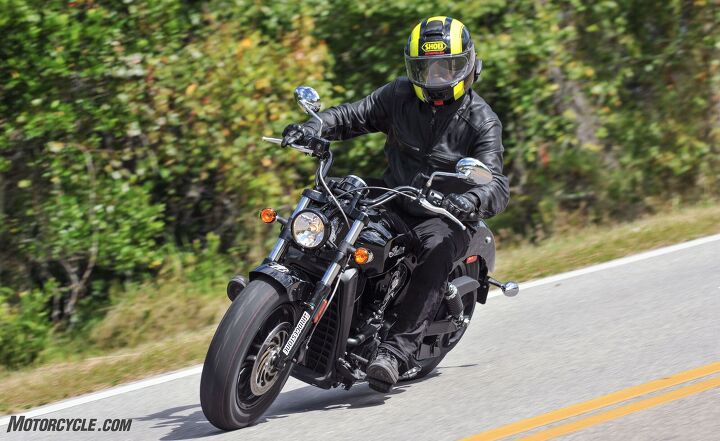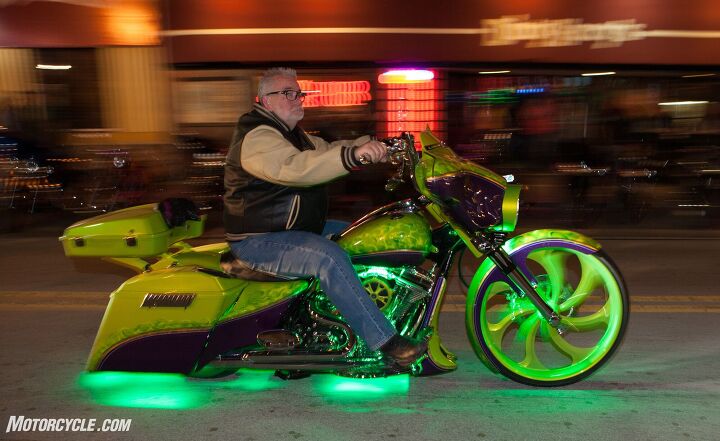Motorsports Racing News & Blog Articles
Black Magic: Motorcycle Tires
As motorcyclists, we are well aware of how important tires are. Our ride – even our survival – depends on just a few square inches of rubber. So, why is it that rarely does a week go by in which we don’t see a motorcycle out on the road with visibly under-inflated tires? These are tires that are way past the point of affecting handling and into the zone of being dangerous. Perhaps it’s because tire technology has advanced so much in recent decades that we take them for granted. It used to be that one of the easiest upgrades you could make to your bike – particularly for sport-focused riders – was getting rid of the OEM tires and spooning on some aftermarket rubber. Now, street tires can offer grip that would surprise racers from a decade ago while still delivering reasonable mileage. Additionally, less performance-oriented tires are now capable of considerably more wet-weather grip and durability, a real boon to commuters and touring riders.
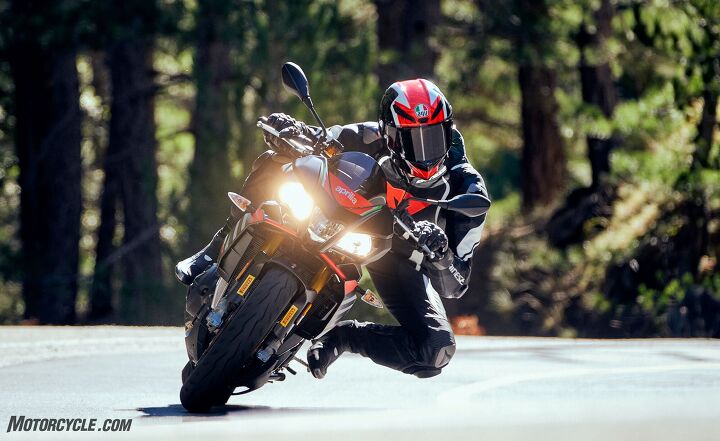
You don’t have to ride like this to benefit from the advances in modern tire technology or the longevity afforded by proper care and maintenance.
However, tires still depend on the end user to attain maximum performance and durability while they sacrifice themselves for our riding pleasure. So, I reached out to representatives from Avon, Dunlop, Metzeler/Pirelli, and Michelin to find out what we need to do (and why) to get the most out of our motorcycle’s rubber.
The genesis of this article was a simple question from a forum that I frequent. Who knew that a single question could send me down a rabbit hole for months, but since the people that I was talking to were the technology-focused types behind the development of tires, I learned very quickly that the answer to my simple question leaned, in many ways, on an understanding of many interlinked factors. Naturally, the answers to a sport-focused question would have a sport-riding-centric answer, but there is still plenty to learn here for riders of other motorcycles.
The question that started this 5,500 word opus? “When sport riding, should street riders run the manufacturer’s suggested tire pressure or something slightly lower for better grip?”
Choose the right tire for the job
Once upon a time, pretty much all motorcycle tires had similar construction. They were black and round and were filled with air. Then came the categories of tires. So, you had the off-road tires, the touring tires, the cruiser tires, the sport-touring tires, the sport tires, and the race tires. However, as technology marches forward, we now have categories within categories. The recent trend of track day tires is a great example. This all comes from the fine-tuning of the attributes that the individual tires feature from wheel fitment to carcass construction to tread compound to tread profile and adds up to a huge menu of tires to choose from. In a recent conversation with representatives from Avon Tyres, I was informed that the company lists over 200 different tire specifications spread out over 10 different categories.
When you’re choosing a tire for your motorcycle, you don’t just want to throw any old tire on it, and for your own sake, don’t listen to the people who say it’s safe to mount an automobile tire to the rear of a motorcycle. These people are clearly deluded and should not be trusted about anything – except, perhaps, the ambulance ride times to the local hospital.
All four tire manufacturers I consulted agreed that to get the most from the investment in rubber, riders need to buy the right model for their particular riding. Each had a list of questions for riders to consider, and when combined formed these common themes: What is the type of riding you do? In what kind of weather? What type of motorcycle do you ride? If you are a sportbike rider, are you looking for more grip or more mileage, and do you ever do track days? Next, they recommended that less experienced riders talk to their local tire vendor. More experienced motorcyclists most likely have a pretty good idea of what category they fit into, but that doesn’t mean they shouldn’t do their due diligence. Tire technology is changing incredibly quickly. So, you need to pay attention.
What differentiates the categories of tires? At the most basic level, the differences start with two separate but somewhat interrelated features: construction and load carrying capability. Bias-ply tires, for example, are quite good at carrying heavier loads, which is why you commonly find them on heavyweight cruisers and baggers. Bias ply tires run their carcass layers of fabric cords from bead-to-bead in alternating layers at an angle (at a bias, which is how they get their name) to each other. This construction makes them stiff and strong – a plus for carrying heavy loads. Unfortunately, the additional thickness in the carcass presents a problem when it comes to shedding heat, which is less than optimal when it comes to sporting use.
Radial tires have their carcass constructed with their cords running directly across the tire from bead-to-bead perpendicular to the tire’s rotation. This construction with fewer layers of body cord allows for a more supple sidewall, which helps make the contact patch larger when the tire is on the edge of its tread. Not surprisingly, performance-oriented motorcycles primarily utilize radial tires because of the higher grip and improved feedback the more supple sidewall allows. Another feature of radial tires is their ability to have short sidewalls with wide treads. Look at your typical sportbike rear tire’s dimensions. They simply wouldn’t be possible with bias ply tires.
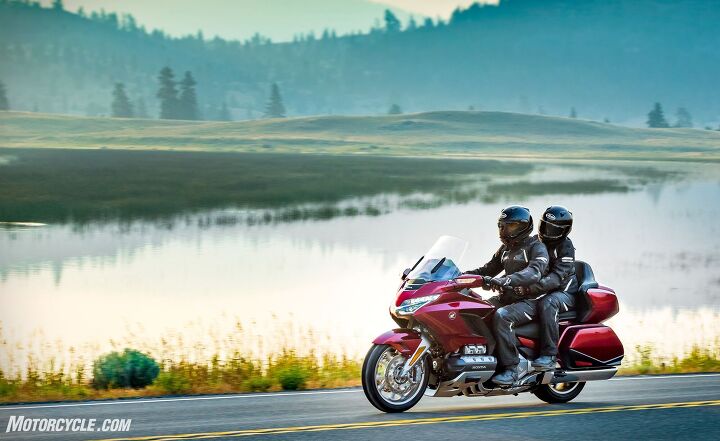
Sportbikes aren’t the only motorcycles that benefit from radial tires. Touring bikes and cruisers can also take advantage of them.
However, that’s not to say only sportbikes use radials. The Honda Goldwing comes with radial tires, and it is certainly a bike that is capable of carrying two large-sized people and their cargo. So, the lesson is that you should know what kind of tires your bike was originally fit with and continue doing so.
Next, riders should consider the rubber compound(s) that make up the tread of the tire itself. Those of us who live for the next apex and can be seen carving up mountain roads typically are willing to sacrifice longevity for cornering capability and often opt for the stickiest rubber available. However, you still need to be aware of the conditions the tire you’re mounting on your bike is designed to handle and what you’re actually doing with it. The long and short of it is that race compounds don’t belong on the street.
Oscar Solis, Senior Roadrace Manager, North and South America Metzeler/Pirelli: “If you have a really sporty compound, if it’s an ultra-race compound like our Pirelli SC0, they’re not made to be at 120 degrees. They’re made to be at 200-plus degrees Fahrenheit. It’s very difficult to get that kind of heat in the tire on the street – with an SC0 or any kind of tire. So, your ultra-race compounds are actually going to be a harder compound at a lower temperature. Even if you had the skills to ride the bike to generate the heat on the track, you most likely won’t be able to get that much heat on the street. So that’s why you shouldn’t have race compounds as street tires.”
This is not to say that performance riders don’t benefit from buying the stickiest street tires they can buy.
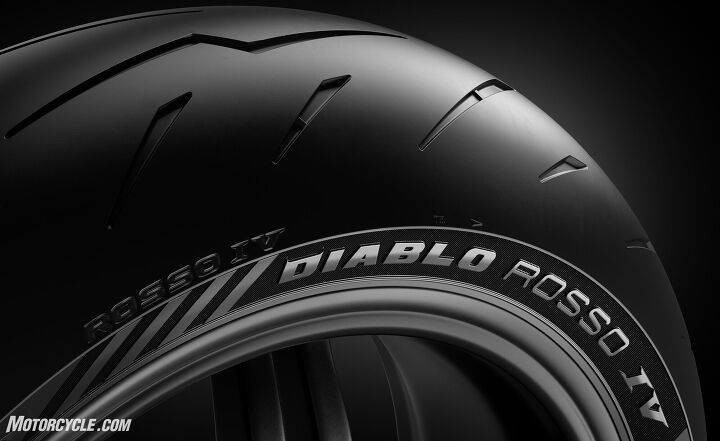
All motorcycle tire manufacturers are making tremendous strides in delivering sticky sport tires that don’t wear out as quickly as those in the past. The Diablo Rosso IV is Pirelli’s most recent example. The stated areas of focus on the tire’s development were “benchmark performance in both dry and wet” and “tread design optimized for sporty riding and regular wear.”
Oscar continues: “We’ll look at the Supercorsa SP. It’s a hyper sport tire, and it’s very aggressive. It’s a very sticky tire. Whenever I ask somebody what they’re going to do with this tire, they’ll say something like, ‘I’m going to go commuting. I’m going to go canyon carving. I’m going to the track once in a while.’ If you go to the track once in a while and you’re doing some canyon carving, the Supercorsa SP is great, and that extra amount of grip it offers can be forgiving because it may allow you to make some mistakes and have that safety net underneath you. If you have a tire that’s way more durable but less grip, that safety net might not be there when you’re asking for whatever degree of lean on the brakes and trying to miss a car because you were way too hot coming into a corner. The grip level could really save your butt.
“Conversely, Supercorsas for a commuter bike, that’s a waste of money because all you’re going to do is wear out the center of the tire. You’re only going to go five degrees of lean angle because you just need to pull into the 7-Eleven for some stuff. You’d be much better off with a sport-touring tire, an Angel GT, a Rosso III. Something that has more durability.”
Dominic Clifford, Global Avon Motorcycle Manager, concurs: “We have a road-legal track day tire called the Extreme. We see this all the time, a rider will come to us and say, ‘I want that tire. I don’t care that I will only get 1500 miles out of it. That’s the tire for me.’ What we find is that, in the road application, it is 100% the wrong tire for them. It’s not just the mileage. In road application, it is very difficult to keep the heat in that type of tire. It is designed for track use, not for stopping and starting at lights, junctions, etc.”
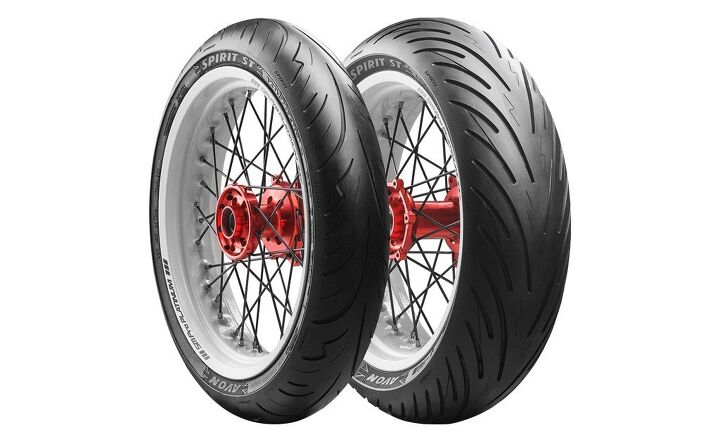
A quick glance at the Avon Spirit STs above tell you that this sport-touring tire was designed with wet-weather grip in mind (in England, that’s of particular importance) along with dry-weather performance.
The difference between hypersport street tires and sport-touring tires is about more than just the rubber compound. You also need to consider the difference in carcass stiffness and tread profile and how they affect handling.
Ashley Vowles, Avon Motorcycle Tire Development Manager: “From a tire standpoint, they are designed very differently specifically to application. Hypersport track tires are designed to be very stable at high-speed. They’re designed to provide optimal grip at higher operating temperatures, and the profiles are designed a lot sharper to enable the bike to turn it in and fall right onto the edge of the tire when the rider is going around corners and hitting the apexes.
“When looking at sport-touring tires, they are slightly similar to hypersport tires, but the construction is slightly different. The track tire/sport tire has quite a lot stiffer construction so that the rider gets optimal feedback from the tire. Whereas sport touring is slightly softer in construction to improve rider comfort. But also the profile is slightly flatter than a sports tire. Sport-touring tires offer a little more footprint because they’re upright a lot longer than on a sport tire.
“Also, you generally get dual compounds on the rear of those tires. The sport-touring tire is designed for high mileage. Sport-touring tires people kind of refer to them as the all around, all season type tire. People are commuting on them. People are using them all year round. They’ve got good dry performance, good wet performance, good longevity, good handling and stability.”
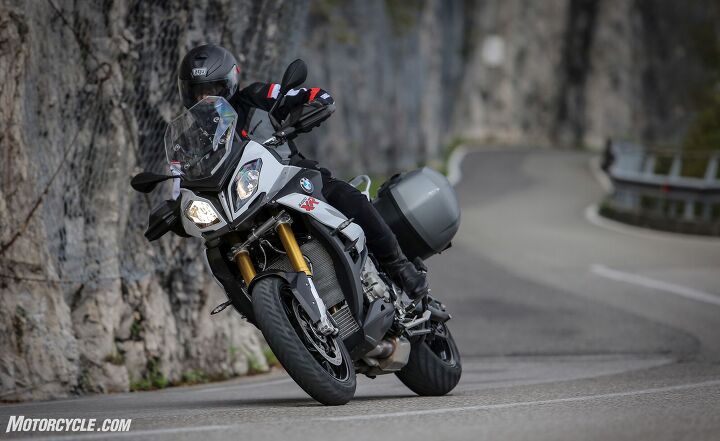
Sport-touring tires are probably the closest to a universal motorcycle tire. They offer a great balance of wet- and dry-weather grip along with good wear characteristics.
Daily commuters would be throwing money away on the stickiest rubber in their workday bump-and-grind, when sport-touring tires offer almost the same grip on the street while delivering many more miles per set.
Still, the decision doesn’t stop with just the compound. Tire choice also depends on where the rider lives. A tire with the bare minimum of sipes – as close to a slick as possible – will suit riders in the arid Southwest or riders who never ride in the rain, but enthusiasts from wetter climates appreciate the ability to channel water away from the contact patch in addition to dry grip. Since cruisers and tourers are less interested in outright lean angle than comfort and longevity (plus wet weather performance for the travelers among us), these tires emphasize durability and the ability to handle the forces that the public roads throw at them and the heavier loads they tend to carry. Finally, we can’t ignore the role that styling plays in tire choice.
Tire Pressure is key
Now, we arrive at the impetus for this article: How do riders get the most out of their tires? We’ve heard about special pressures for track days. Should rider’s vary their pressures for different street-riding jobs? Or should they set their tire pressures (which they are checking at least weekly, right?) to OEM specifications and not worry about it at all?
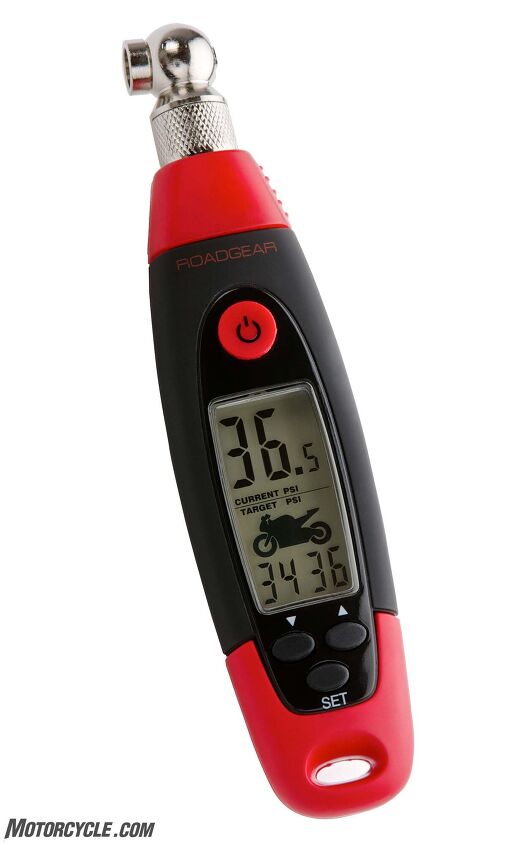
If you take away nothing else from this article, understand that the secret to getting both the best performance and durability out of your motorcycle tires is to buy an accurate tire pressure gauge and to use it regularly.
Among the tire companies I consulted, the unanimous statement was that you couldn’t go wrong with running the OEM-recommended pressures on the street. However, there were some caveats.
Vowles @ Avon stated: “For 90% of our tires, we recommend the OE pressures for that motorcycle…There are a few sizes and few bikes where we do recommend a different pressure, on our custom stuff, especially, where we might have a slightly higher pressure.”
Clifford @ Avon adds: “Tire pressures are very important. You should be increasing your pressures if you’re riding with luggage and pillion. The pressures we recommend are for cold tires in a road application. If you are going to ride with a pillion and or luggage, we’d always recommend increasing 1 or 2 PSI in that tire as well.”
Shawn Bell from Sumitomo Rubber USA (Dunlop’s parent company) concurs: “The first thing I recommend is check with the motorcycle manufacturer. They have ideal air pressure settings when it comes to the capabilities of the motorcycle. We actually have a 1-800 number (800-845-8378) that we get a lot of customers calling in and asking questions like this, and we always recommend running OE placard pressure on the street.”
Michelin responded in a written statement from its engineering department: “For street riding purposes, Michelin recommends the tire pressure quoted by the motorcycle manufacturer…Road pressures are defined by the motorcycle manufacturer to cover all possible uses of the motorcycle, ranging from slow speed commuting to work in an urban environment all the way to two-up on the highway (high speeds sustained in a straight line).”
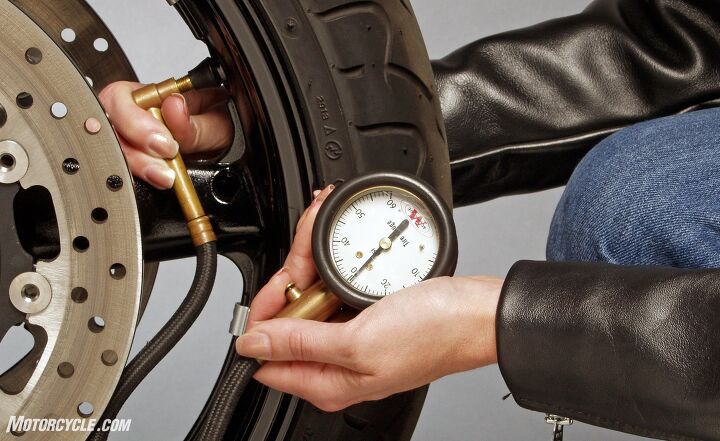
For a regularly-ridden motorcycle, weekly pressure checks are the minimum. Still, according to the tire reps, we should do it before every ride.
Solis @ Metzeler/Pirelli, said: “It’s always going to be the bike manufacturer’s recommendation. They build the bike. When we build a tire, it’s not necessary we build the tire for every motorcycle. Instead, we build a tire that can go on a handful of motorcycles. It’s the bike manufacturer’s pressure recommendation because it is more of a singular application for the bike and rider than just the tire itself.”
So, the common thread in all of this is that the OEMs know what the motorcycle is capable of and the kind of stresses that it will put on the tires in the range of operating conditions expected of it. The cynics among us will say that this is largely a CYA statement to avoid lawsuits, but the engineers and test riders responsible for developing street bikes really know what they’re doing.
The most common mistake
Let us pause for a moment of silence to consider the suffering inflicted on motorcycle tires by neglectful owners – and let their tales of woe be a warning.
Bell @ Dunlop: “At rallies, we would set up a tire check, people would come through with their motorcycle, and we would check their weight and pressure. We’d have them roll up on the scale and sit on the bike with everything, their luggage, the wife on the back, and we would get the weights front and rear. Then we would check their pressure. And the number of under inflated tires was surprising. We even came across some riders with less than 10 psi in their tires. It was kind of scary and comical at the same time. We’re telling people, you don’t understand how important this is.
“We found in our testing that you’re going to get the best mileage bang for your buck on the street if you maintain the placard pressure. As soon as you lower that pressure, you’re putting more heat cycles into the tire. You’re definitely generating more flex in the carcass, and that’s going to wear the tire out. I couldn’t tell you how much quicker. I know that it’s pretty obvious to me when I have seen a street motorcycle running too low air pressure, either it wears out too quickly or wear is uneven. You get cupping.”
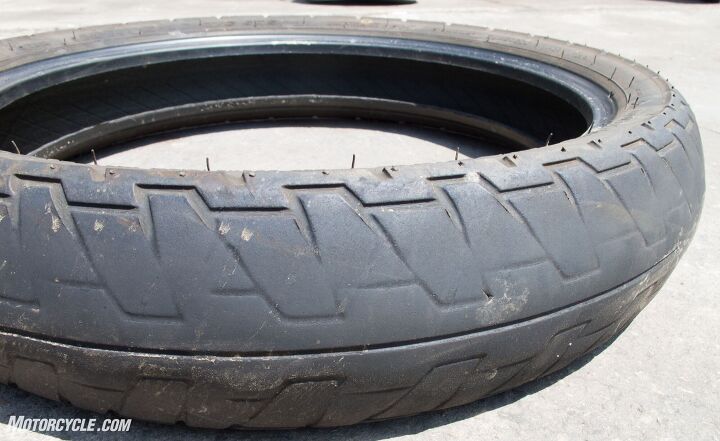
This basket case of a tire shows clear signs of being used while under-inflated. Note the cupping of the tread while the center still has rubber left.
Solis @ Pirelli: “Check your pressure. Every time you go out on a ride. Nobody ever does it, but I’m still going to suggest that you do it. Check your pressure every time – especially when the weather changes. That’s what really changes the pressure in the tire. Heat is generated in a tire by deflection, by how much it squishes, basically. On the road, less pressure is going to create more heat. That’s why big truck drivers in semis get blowouts when the pressure is too low. It creates more heat. The heat’s not so much on the surface. It’s actually under the surface. That’s why you see the tread come off.”
Clifford @ Avon: “The one stat that I always talk about is that you should look at tire wear as a bell curve. The optimum pressures in the middle. If you go ten percent either way on your pressures, then tire wear literally drops off the bell curve.
“So, your optimum wear rate is at 42 PSI. If you go plus or minus on the 10% rule, and a lot of riders will for a 42 PSI recommendation. They will probably drop that down to 34 or 35, but even 10% so from 42, that’s about 38 PSI. Even if you’re 38, that will, in some cases, increase your wear rate by 50%. So, you will get half the mileage out of your tire by running it between 35 and 38 than you would do at 42 PSI.”
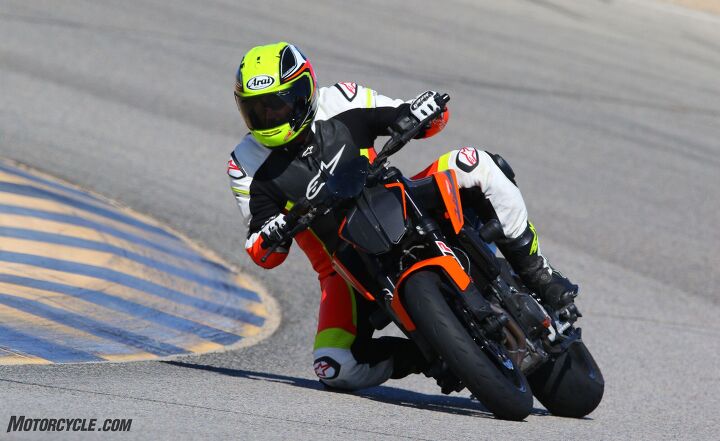
Track pressures are for the track, and street pressures are for the street. There is actual science behind these settings.
Vowles @ Avon addresses the desire for a bigger footprint provided by running slightly lower pressures when sport riding. Moderation is the key here: “Yes, you are going to potentially have a bigger footprint, but at the same time you’re also going to change the complete construction of that product because it’s going to be a lot softer in the sidewall. It’s going to wallow around; you’re going to wear the tire out. You’re going to have tires moving around, which can generate more heat as well. So, you can risk overheating the tires. Now, it may be that on some bikes an end user, instead of having 36/42, he’s gone 34/40, and he likes it like that. Okay, that’s okay.”
To wrap up this section, it’s time to get really honest with yourself. When did you last check your bike’s tire pressures? If it was in the last week, you’re better than most. If you can’t remember, you could, at best, be throwing away money on rubber that you’re wasting and, at worst, endangering yourself (and others). Motorcycle tires are serious business.
Track pressure is a special case
The track environment is quite different from the street. The extreme loads are nearly constant, going from braking to full-throttle acceleration back to braking and leaning over in a corner. This generates heat quickly and can push tires not made for the environment well out of their temperature range and cause them to become greasy. Another component of the heat build up in tires on the track is how it affects pressure rise.
Michelin puts things succinctly in its written statement: “Circuit pressures are traditionally defined by the tire manufacturer for track use only. It is not recommended to ride on the road with these pressures.
“For track use, the front tire pressure is lowered so that when it is hot, the tire operating temperature is close to the cold road pressures. “The rear pressure is lowered significantly on track versus street because the pressure needed to support two-up is not required and thus a lower pressure achieves a more optimal operating temperature.”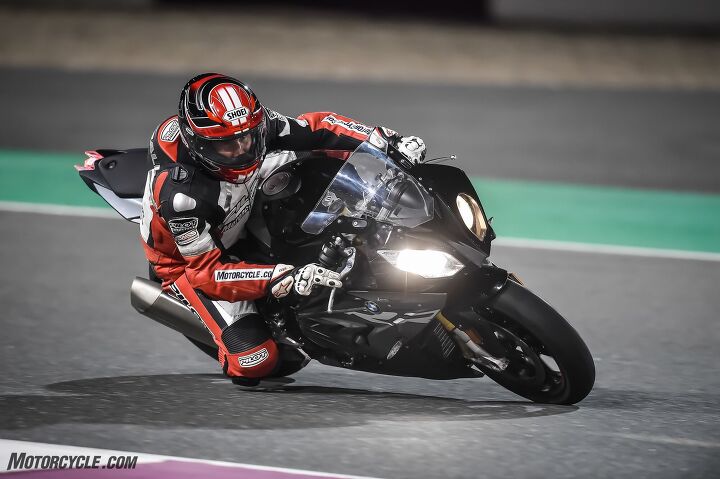
Track pressures serve multiple purposes. First, the lower pressure helps to manage the increase in tire pressure as the carcass temperature rises. Second, the size of the rear contact patch can be adjusted to give better drive out of the corners.
Bell @ Dunlop reveals that the issue is about more than just tire temperature. For example, street settings have higher rear pressure than front, but at the track things are reversed: “[On the track] the lower pressure on the rear is because of the benefits of the increase in contact patch that you’ll get, specifically for the drive out of the corners. The air pressure on the rear, when it gets hot, increases more than the front. If you started off with 32 in the front and 30 in the rear, you’re gonna end up with 36/36 hot. Just because of the volume of air inside the tire, you’re seeing a bigger increase on the rear.
“I always say that it’s important to check the hot pressure because, when you’re on the track, you’re not normally riding on cold tires. You’re on hot tires. If you want to hone in on air pressure, I recommend checking the hot pressure, but you have to start with something. You have to start with a cold pressure [which is information that a tire vendor will have].”
Solis @ Metzeler/Pirelli emphasizes that novice track riders or riders that don’t have track experience with the tires they’re running should talk to a tire vendor: “ When you take tires to the track, talk to somebody. Talk to trackside vendors about pressures. Yes, you go lower to get a little more grip, but they’ll help you out with the specifics of those pressures and make sure that you’re not going to overheat your tires. With true track race tires, it’s very very hard to overheat them. Most of the time, it’s the track that actually loses a lot of grip when it gets too hot. You have to keep in mind that friction is from two parts, the tire and the track. Maybe the tires lose their grip and maybe it’s the track losing grip. A lot of the time, people don’t realize the track loses its grip, and you have to do something with the tires or suspension to kind of compensate for that.”
The final word on track tire pressure is talk to the people who know the tires you’ve mounted and then, if you have the skill set, adjust from there to suit your preferences. If you’re new and don’t have the skill set, then we’ll reiterate the importance of contacting a reputable tire vendor ahead of time to seek proper tire pressures to start with. Odds are you’ll stick with these pressures for the whole day. Remember that not every tire brand will have a representative at your track day. So, again, get the information you need prior to arriving at the track.
On running non-standard tire sizes
This topic can get fairly far off into the weeds if you include custom cruiser show bikes that are all about the form with little – if any – thought about how the bike will handle. Still, a surprisingly large number of riders think that the hot set up is to put larger tires on their bikes. Here’s what the tire reps had to say about it.
Again, Michelin wins points for brevity, getting to the crux of the matter: “For street riding, motorcycles should be equipped with the size of tire specified by the motorcycle manufacturer. Do not mount tires wider or narrower than the original-equipment tires, either of which could negatively affect the motorcycle’s handling. Exceptions to this guidance should only be considered with qualified tire support specialists; i.e. trackside tire support (190 rear width vs 180 rear width, etc.).”
Solis @ Metzeler/Pirelli says you should check with the tire and bike manufacturers’ specifications: “When we create a tire and when we engineer a tire, we actually engineer for a certain size rim. As long as the tire manufacturer says the application is for this rim size, then it’s been tested that way. A 180 to 190, the profile doesn’t mean it’s the same right? The profiles are different. If you go with a different size with the same rim size, it’s going to pinch the profile. What happens is it kind of curves a little bit more. When it’s on the street, that means that it doesn’t quite go all the way to the side of the tire. It kind of stays up a little bit more on the tread. That could be bad because, when you go all the way to the side of the tire, you deflect the sidewall a little bit more and, actually, may have more of a contact patch. You are squeezing that side wall a little bit and getting a bigger contact patch. Not a lot of people understand that. They think it’s just wider, and it’s better: ‘Just pinch that puppy on there. You’re going to have more contact patch.’ But they might actually have less.
“The other problem about it is that the selection of the tires might actually be less as well. The range of tires that you have a certain size may be different. If your bike manufacturer recommends it, fine, go with it. If it doesn’t then, you know, it’s going to change and you might have less availability for your bike.”
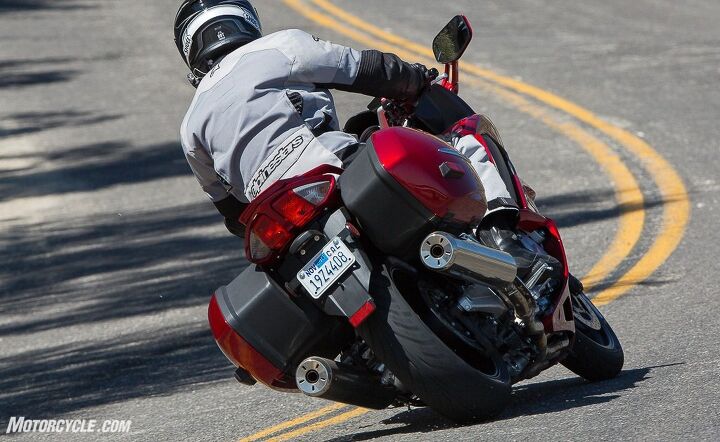
Most riders don’t spend much time thinking about it, but a lot of testing goes into the development of tires and how they affect a motorcycle’s handling. Choose non-standard tire sizes, and you could screw things up.
Bell @ Dunlop: “There are two schools of thought. I think if somebody is going to entertain the idea of trying a non-standard size, something that’s different than the motorcycle manufacturer recommends, they should do as much homework as they can. I wouldn’t recommend just going off of the blogs because somebody said that they did it, and it was awesome. They should try to really understand what they’re doing to the motorcycle because the geometry of the motorcycle is just like air pressure: the manufacturer set up the suspension and the geometry of the motorcycle for its ideal handling. As soon as you change that, you could potentially upset the handling of the motorcycle.
“The information that’s gonna be important is the diameter, because you can change the ride height. Not only are you changing the width of the tire, but depending on the aspect ratio, you can also change the diameter. You’re essentially raising or lowering the center of gravity. That might be great for a track day because you want the quick steering, but I think they should try to understand what they’re doing.
“Clearance with the swingarm is important. Tire size changes at speed. The dimensions we publish are static. That’s not dynamic. Luckily, sport tires are pretty stable. Bias ply tires grow quite a bit. As soon as you start throwing in a wider tire or a taller tire, then you run the risk of interference. My recommendation is that they just need to do their homework and make sure that they’re doing the right thing.
“I know personally, spending as much time as I have at the track, a taller aspect ratio is better for the track. A taller profile gives a bigger footprint when leaned over. It gives quicker handling. Again, those are all things that you want at the track, but is that what you want on the street? That’s another question. It really comes down to where you’re gonna ride.”
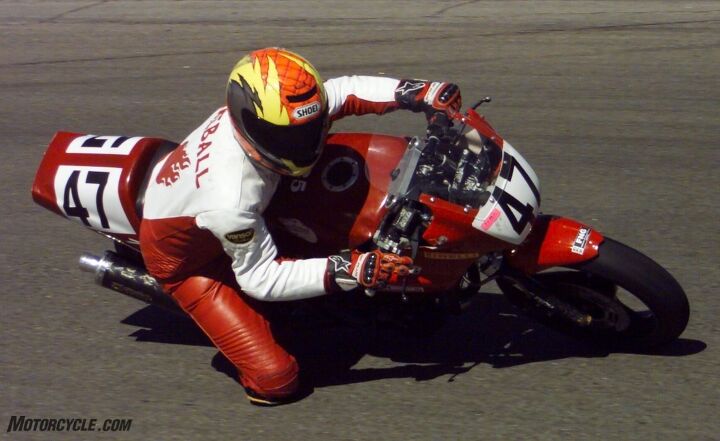
If you look closely at the leading edge of the front fender, you’ll see that my fitting a taller than stock tire caused it to rub against the fender as the carcass expanded at high speeds.
Clifford and Vowles from Avon tag-teamed on this answer:
Vowles: “So if you’ve got a five-and-a-half inch rim on the back of your sports bike that’s designed for a 180, and you want to put a 190/55 or 200/55 on, you are going to dramatically change the performance of a motorcycle. Tires on narrower rims will change the profile. If the tire is designed to be on a 6-in. rim, and you’re going to put it on a 5-in. rim, you’re going to sharpen the profile.”
Clifford: “When you mix in a motorcycle designed for a certain fitment, somebody may put a different size rear tire on. What we find then, in certain situations, is that the front tire and the rear tire aren’t working in harmony. And then you end up with a shimmy, particularly on a sweeping bend because those profiles are not matched. So, they end up working against each other.”
Vowles: “You’ve got one that wants to turn in and the other wants to stand up. It’s our worst case scenario in the tire industry. A motorcycle manufacturer or a tire manufacturer would steer away from that at all costs. We could not ever recommend anything we’ve not tested in application. Always, always stay with your recommended tire size.”
Wrapping it up
While reading this article, you probably noticed that the manufacturers agreed with each other on the broad strokes. These are demonstrable truths that their companies have learned through R&D. You should absolutely heed this advice. In the cases where there are slight differences in their approach to a topic, some wiggle room is implied, meaning that if you know what you’re doing or consult with someone who does, there is room for you to find what works best for you.
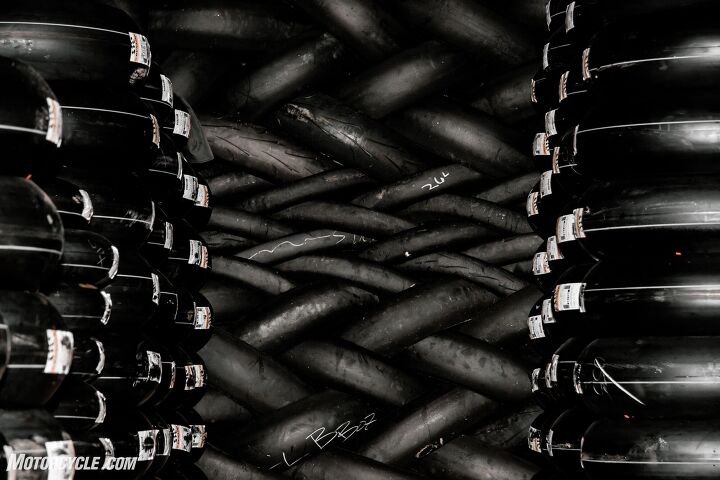
Why would Dunlop haul all these used race tires away from the track? To study and learn from. Street riders will eventually benefit from the technology developed at the track.
FAQ?
Should motorcycle tires be inflated to max PSI?
There is some confusion as to what the Max PSI listed on a tire is. This figure is generated for the motorcycle’s maximum rated load and the pressure required to support that load. As the tire pressure goes down, the maximum load the motorcycle can carry is reduced. Of course, motorcycles spend little of their time carrying that maximum load. So, for regular use, consult the motorcycle manufacturer’s recommended tire pressure to achieve optimal results. These will be the pressures that it was designed to operate with.
What happens when a motorcycle tire pressure is low?
First of all, your motorcycle’s handling will be affected because the tire’s carcass will not maintain its proper shape. Steering will feel heavy. As stated in the article above, low tire pressure puts more heat cycles into the tire because it’s generating more flex in the carcass. At its best, the tire is going to wear out sooner, wasting the money you invested in it. At its worst, low pressure could lead to catastrophic tire failure.
How often should I check my motorcycle’s tire pressure?
The best answer, the answer tire manufacturers always give, is to check tire pressure before every ride. The realistic answer is that for a regularly ridden motorcycle, a weekly check is sufficient. However, if your bike sits unridden for any length of time, definitely check the pressure before you ride it again.
Additional Resources
Best Motorcycle Tires
Best Sportbike Tires
Best Motorcycle Racing Tires You Can Also Use On The Street
Sport Touring Tire Buyer’s Guide
Adventure Tire Buyer’s Guide
Best Motorcycle Touring Tires
Best Motorcycle Cruiser Tires
Best Dirtbike Tires
How To Properly Check Your Motorcycle’s Tire Pressure
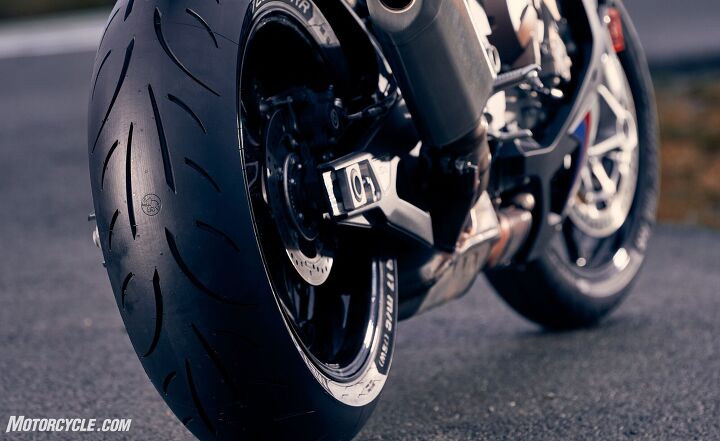
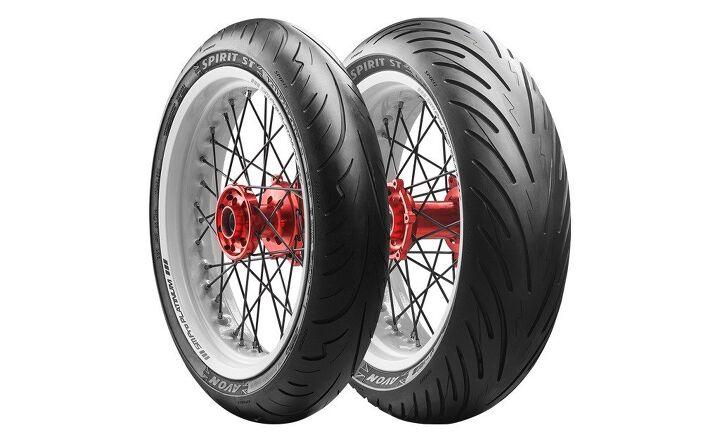
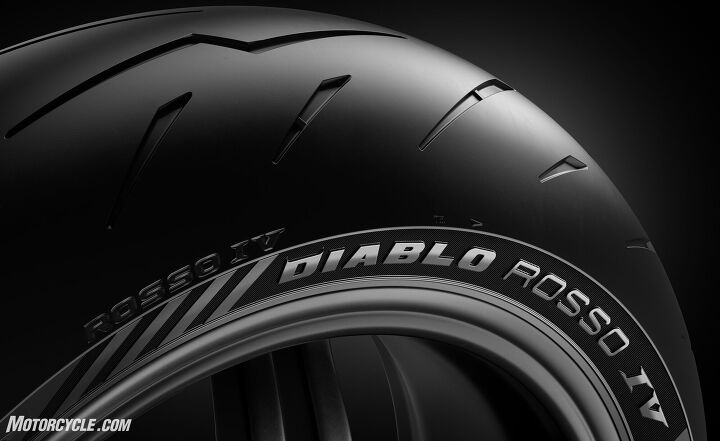
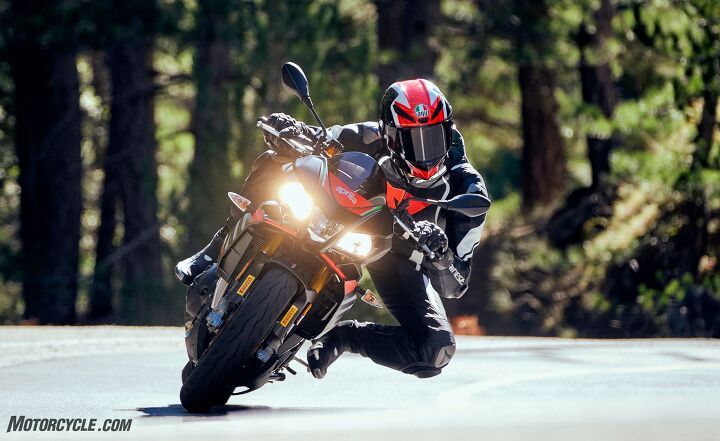
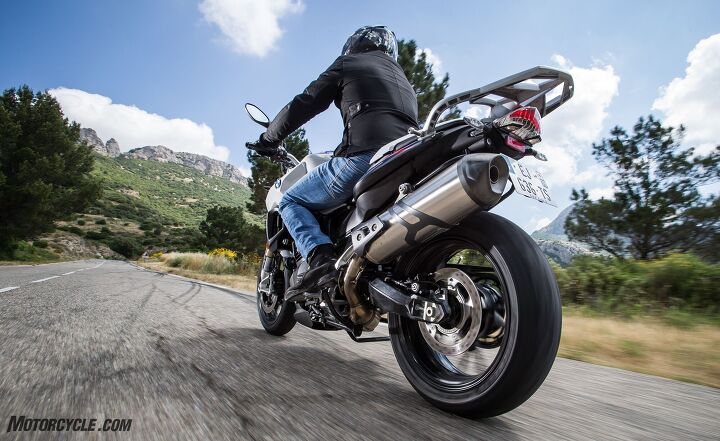
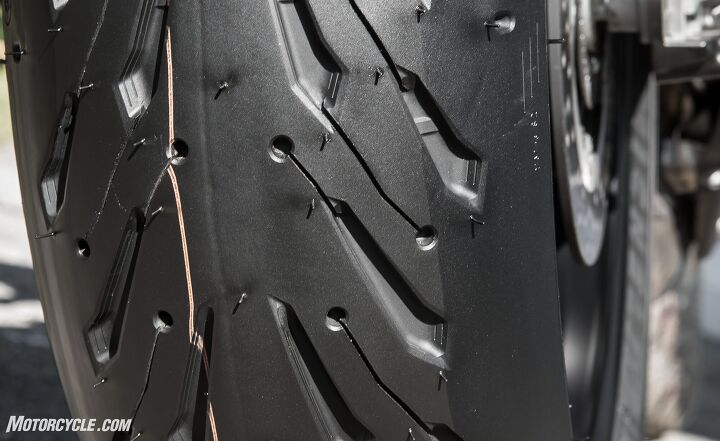
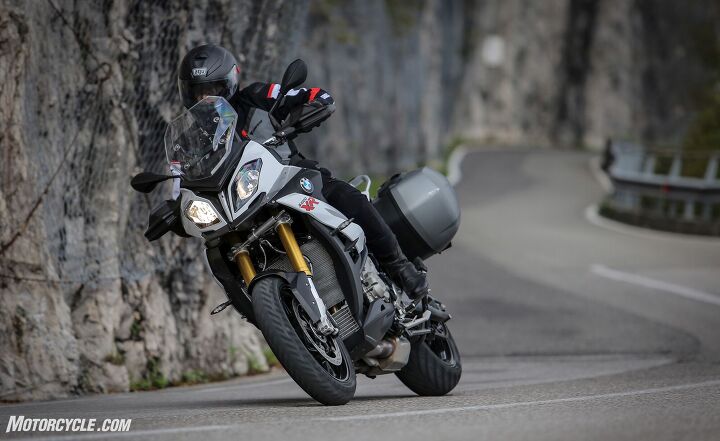
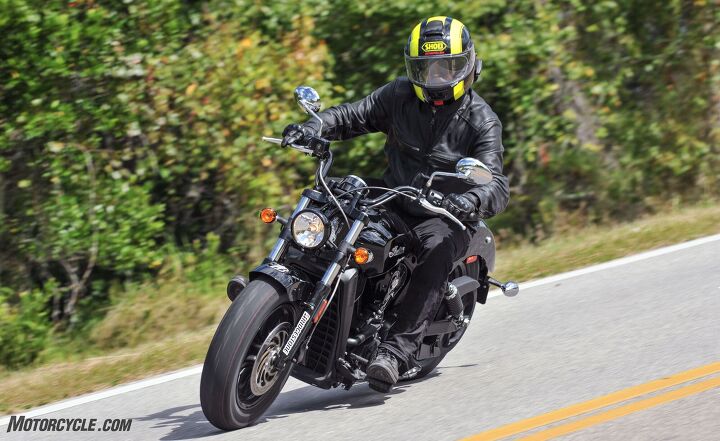
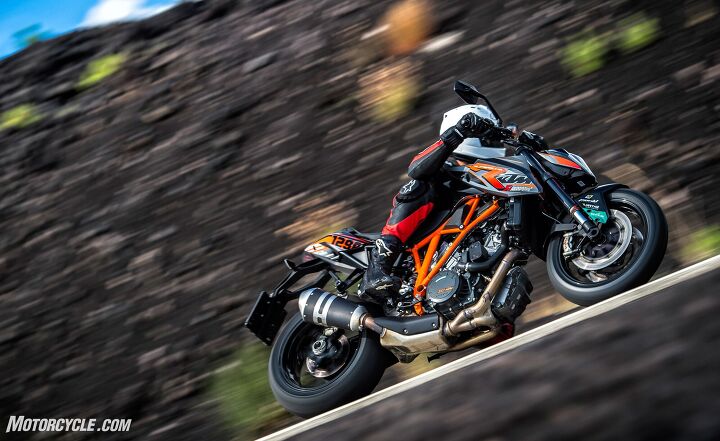
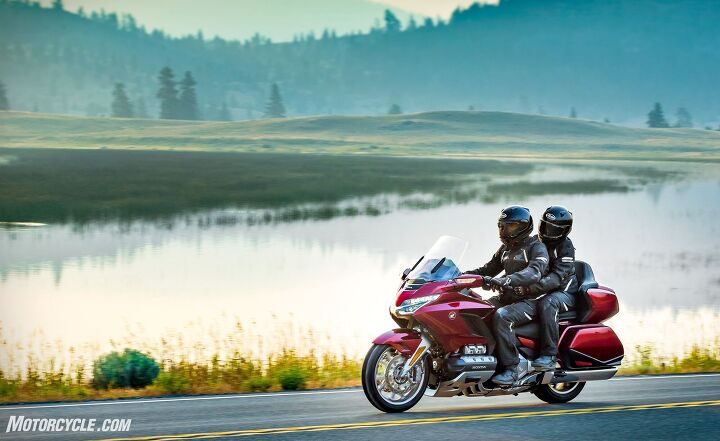
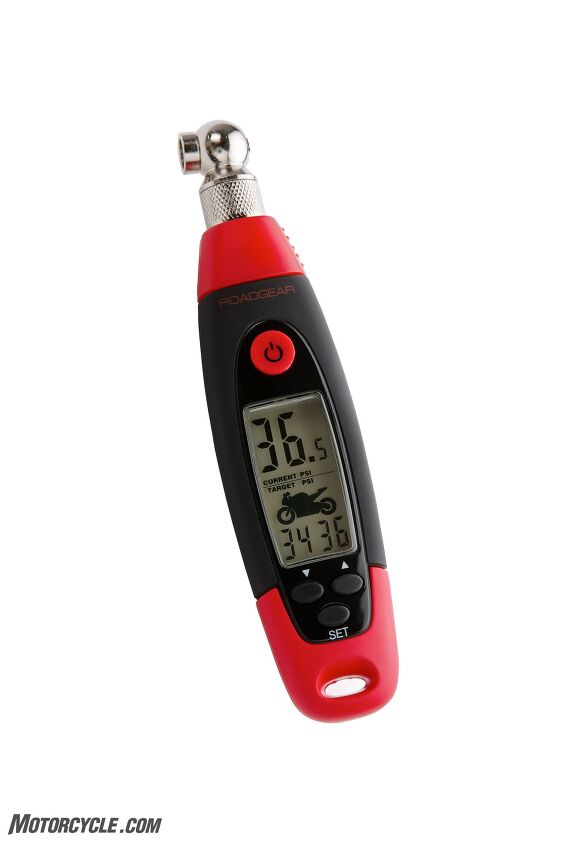
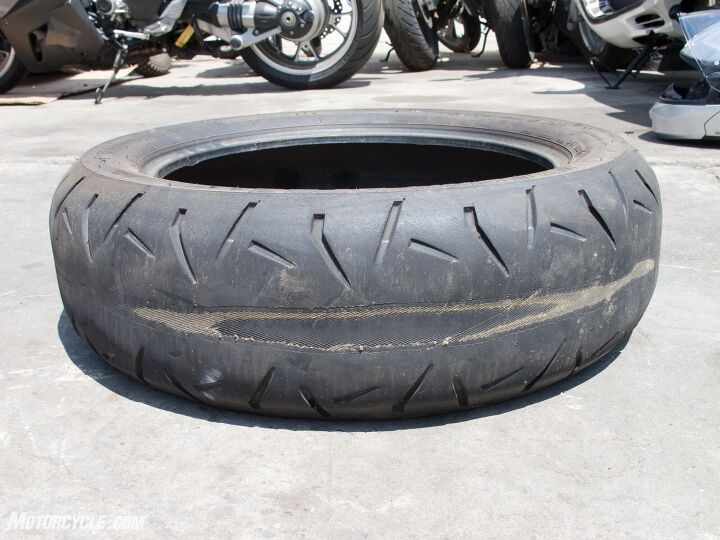
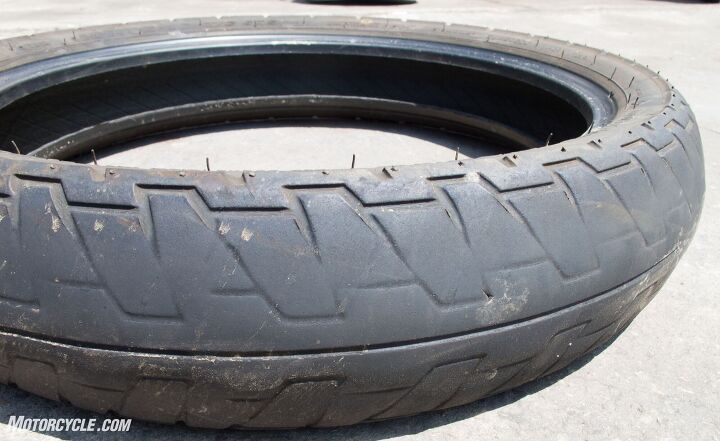
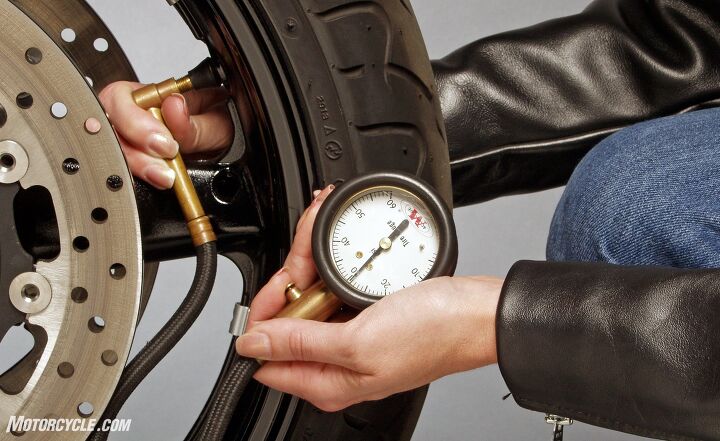
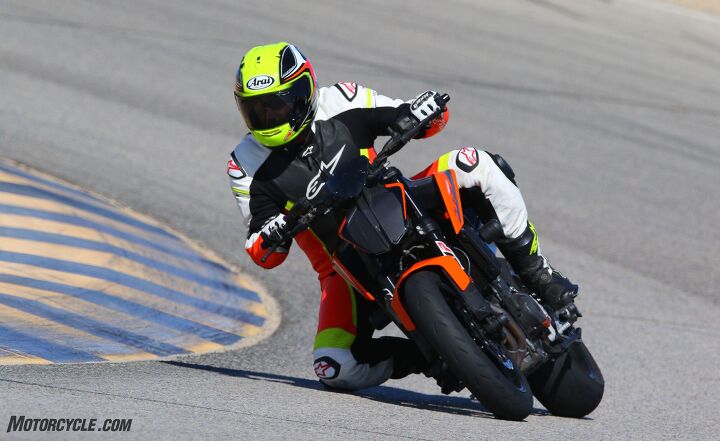
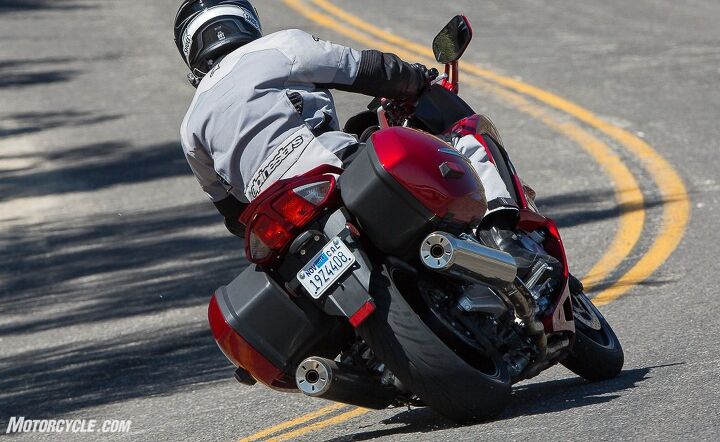
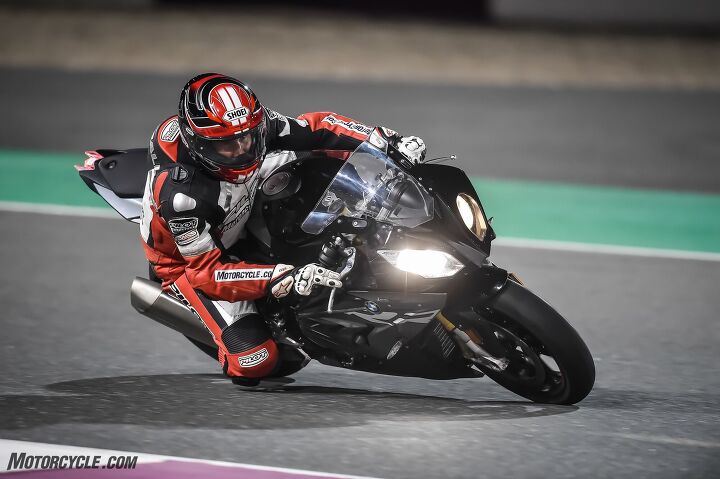
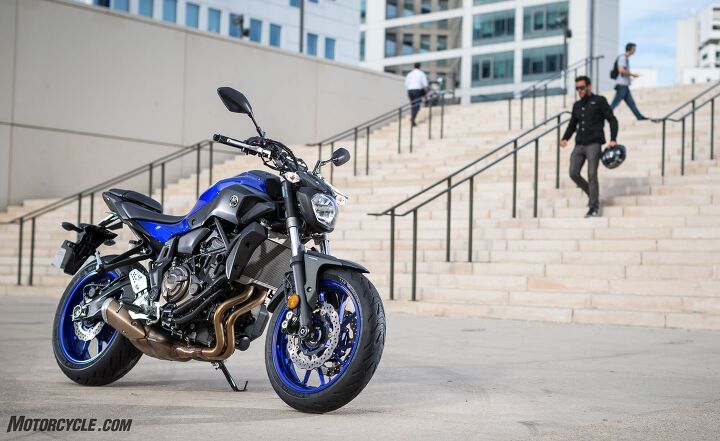
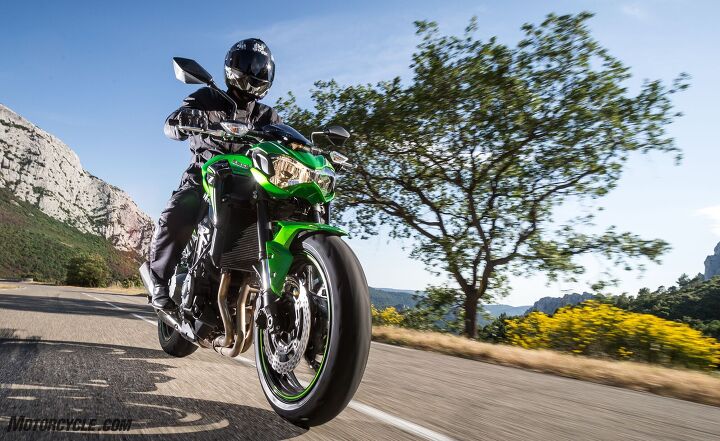
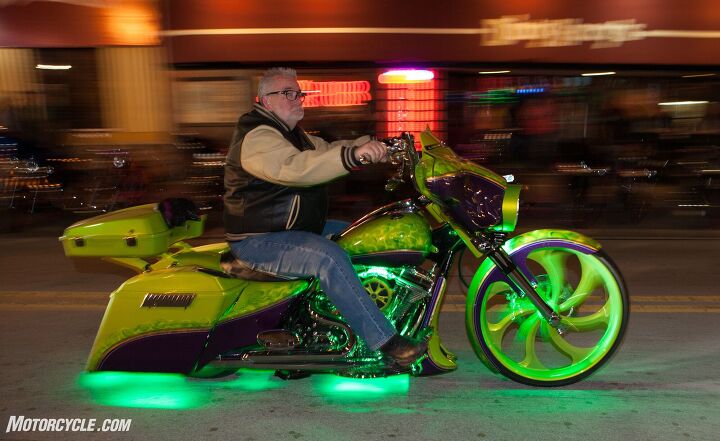
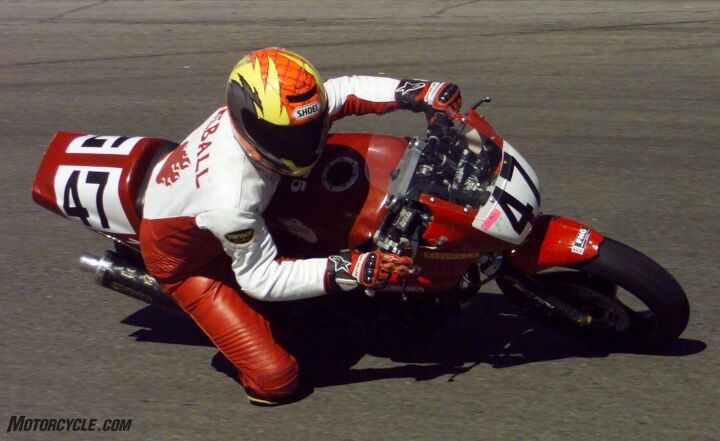
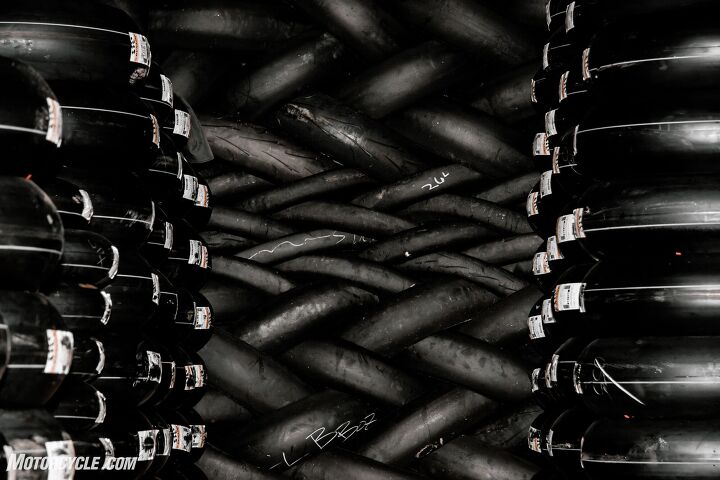
We are committed to finding, researching, and recommending the best products. We earn commissions from purchases you make using the retail links in our product reviews. Learn more about how this works.
Become a Motorcycle.com insider. Get the latest motorcycle news first by subscribing to our newsletter here.
The post Black Magic: Motorcycle Tires appeared first on Motorcycle.com.
Copyright
© Motorcycle.com


